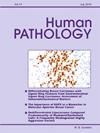Primary adenocarcinoma of the urinary tract and its precursors: Diagnostic criteria and classification
IF 2.7
2区 医学
Q2 PATHOLOGY
引用次数: 0
Abstract
Primary adenocarcinoma of the urinary bladder is a rare malignancy, comprising up to 2% of bladder cancers, predominantly in males. Its rarity and similarity to urothelial carcinoma and secondary adenocarcinomas pose diagnostic challenges. A comprehensive literature review was conducted on the diagnosis, classification, morphological and immunophenotypic characteristics, and molecular profiles of primary adenocarcinoma, urachal adenocarcinoma, and precursor lesions.
Primary adenocarcinoma exhibits diverse morphological patterns, including enteric, mucinous, signet ring cell, and mixed types. Immunohistochemistry is useful in differentiating primary adenocarcinoma from metastatic adenocarcinomas and secondary involvement. Genetic studies reveal mutations common in colorectal and bladder adenocarcinomas (KRAS, TP53, PIK3CA) and novel primary adenocarcinoma-specific mutations (OR2L5). Urachal adenocarcinoma shares morphological features with primary adenocarcinoma but typically occurs in younger patients with unique genomic and distinct immunoprofile. Potential precursor lesions include villous adenoma, cystitis glandularis, and intestinal metaplasia, and warrant close clinical follow-up. Despite advances in histopathological and molecular diagnostics, primary adenocarcinoma remains challenging to diagnose due to its rarity and morphological heterogeneity. Ongoing research into its molecular characteristics is essential to refine diagnostic criteria and therapeutic approaches. Thorough clinical and pathological assessment is crucial for accurate diagnosis, classification, and clinical management.
原发性尿路腺癌及其前体:诊断标准和分类。
原发性膀胱腺癌是一种罕见的恶性肿瘤,占膀胱肿瘤的2%,主要发生于男性。它的罕见性和与尿路上皮癌和继发性腺癌的相似性给诊断带来了挑战。本文对原发性腺癌、尿管腺癌及前驱病变的诊断、分类、形态学和免疫表型特征及分子特征进行了全面的文献综述。原发性腺癌表现出多种形态,包括肠型、黏液型、印戒细胞型和混合型。免疫组织化学在区分原发性腺癌、转移性腺癌和继发性腺癌方面是有用的。遗传学研究揭示了在结直肠癌和膀胱腺癌中常见的突变(KRAS, TP53, PIK3CA)和新的原发性腺癌特异性突变(OR2L5)。尿管腺癌与原发性腺癌具有相同的形态学特征,但通常发生在具有独特基因组和独特免疫谱的年轻患者身上。潜在的前体病变包括绒毛状腺瘤、腺性膀胱炎和肠化生,需要密切的临床随访。尽管在组织病理学和分子诊断方面取得了进展,但由于原发性腺癌的罕见性和形态学异质性,其诊断仍然具有挑战性。对其分子特征的持续研究对于完善诊断标准和治疗方法至关重要。彻底的临床和病理评估是准确诊断、分类和临床管理的关键。
本文章由计算机程序翻译,如有差异,请以英文原文为准。
求助全文
约1分钟内获得全文
求助全文
来源期刊

Human pathology
医学-病理学
CiteScore
5.30
自引率
6.10%
发文量
206
审稿时长
21 days
期刊介绍:
Human Pathology is designed to bring information of clinicopathologic significance to human disease to the laboratory and clinical physician. It presents information drawn from morphologic and clinical laboratory studies with direct relevance to the understanding of human diseases. Papers published concern morphologic and clinicopathologic observations, reviews of diseases, analyses of problems in pathology, significant collections of case material and advances in concepts or techniques of value in the analysis and diagnosis of disease. Theoretical and experimental pathology and molecular biology pertinent to human disease are included. This critical journal is well illustrated with exceptional reproductions of photomicrographs and microscopic anatomy.
 求助内容:
求助内容: 应助结果提醒方式:
应助结果提醒方式:


